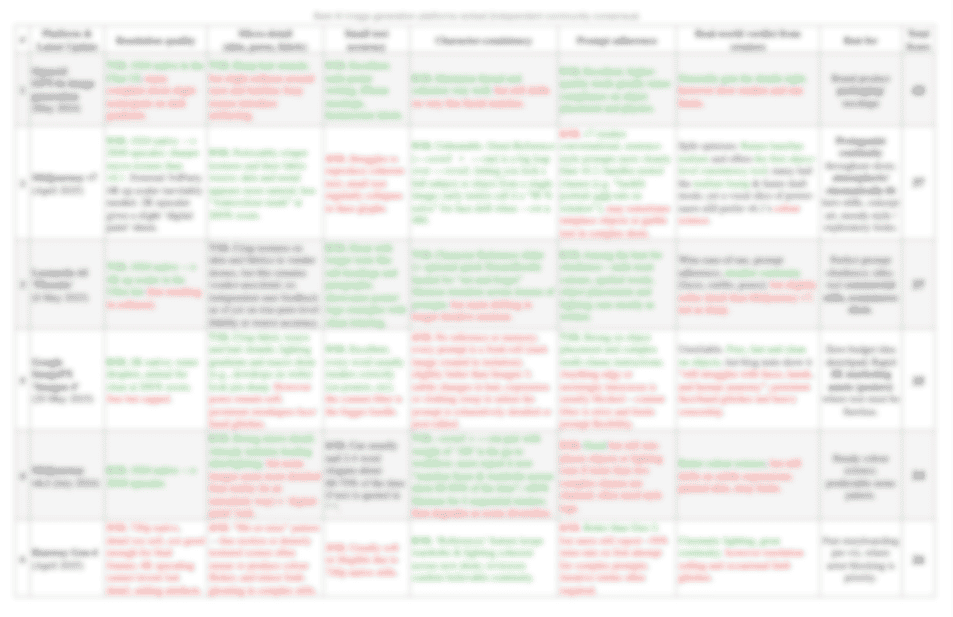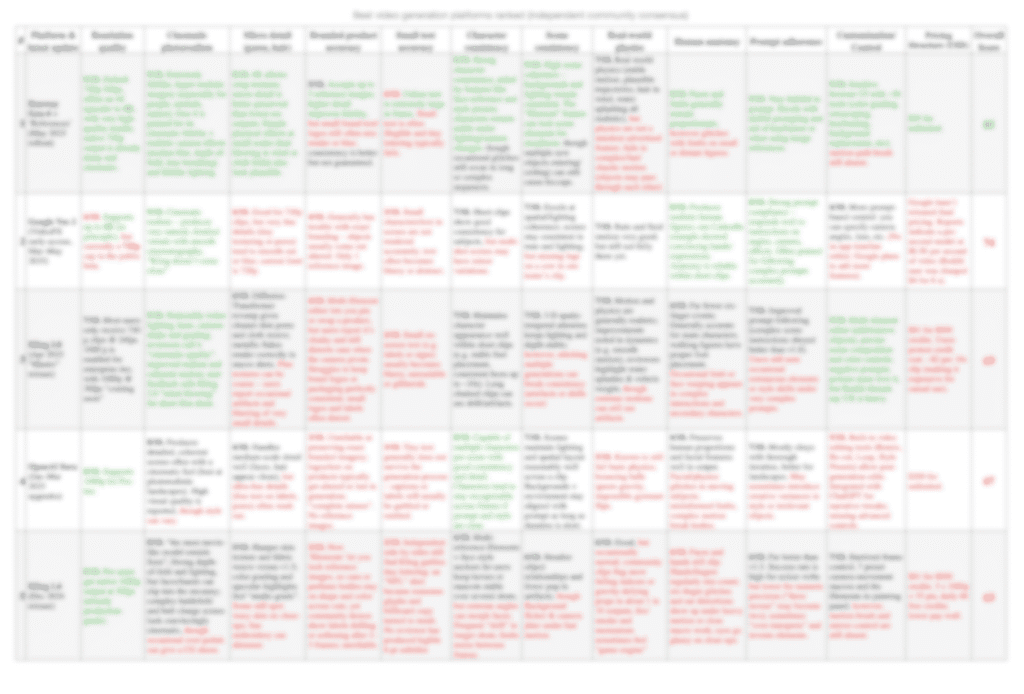Reading time: 4 mins
Independent community scoring across 5 technical and creative criteria
The independent artist and creator communities have spent the past year rigorously testing every major text-to-image engine. Their verdicts, distilled below, balance pixel-peeping technical quality with the day-to-day realities of speed, consistency and price. Drawing directly from those crowd-sourced scores, here’s how the six leading platforms stack up in 2025.
Note: the below assessment is up-to-date as of 22 May 2025.
1. OpenAI GPT-4o Image Generation — 80/100

OpenAI’s first model natively built into ChatGPT still tops the chart for its all-round dependability. While its 1024p native resolution can show mild grain on dark gradients, it compensates with best-in-class prompt obedience and near-flawless small-text rendering (think iPhone mock-ups and poster headlines). Character cohesion holds strong across iterative shots, and the new “higher-quality” toggle boosts physics realism without extra prompt wrangling.
The trade-off? Slow renders and chat-style rate limits mean you’ll queue during peak hours.
For tight-detail product mock-ups where typography matters, GPT-4o remains the safest bet.
2 ∙ Midjourney v7 (Apr 2025) — 74/100

Midjourney’s biggest leap since v6.1 doubles down on photorealism. Native 1K → 2K upscale delivers crisper fabric weave and natural skin, while the new Omni-Reference (--oref + --ow) tool is hailed as a “90% fix” for face drift when weight is cranked above 400. Text, however, is still its Achilles heel; anything beyond a two-word slogan dissolves into faux glyphs. Some long-time power users also lament a subtle “digital-paint” sheen after 2K upscaling. If you need cinematic key art with rock-solid protagonist continuity, v7 is the community’s darling.
3 ∙ Leonardo AI “Phoenix” — 74/100

Leonardo closes the gap with a friction-free “Character Reference” slider and one-click DreamBooth that locks faces and outfits across dozens of prompts. It nails paragraph-length text and colour instructions, making it a favourite for ecommerce stills and brochure work. Detail is fractionally softer than Midjourney v7, especially after its 4K upscaler, but prompt obedience is second to none. Creators reach for Phoenix when accuracy and speed beat out microscopic pore fidelity.
4 ∙ Google ImageFX “Imagen 4” — 70/100

Imagen 4 is the free, fast 2K sketchpad every zero-budget creator wanted—until Google’s strict content filter redraws your prompt. Resolution and small-text fidelity rival GPT-4o, and hair or water droplets look razor-sharp at 200% zoom. But without any reference memory, each render is a roll of the dice; subtle changes creep in unless you overspecify every detail. Persistent face/hand glitches further dent trust for human-centric work. Its sweet spot: posters or marketing assets where flawless typography trumps anatomical perfection.
5 ∙ Midjourney v6.1 — 68/100

Still beloved for its lush colour science and predictable noise pattern, v6.1 still retains a place in many pipelines. The classic --cref + --cw 100 flow holds about 80–90% likeness through a short series, but faces drift as scenes diversify. Text hit-rate hovers around 60–70% for four-word slogans, and object placement can falter in clause-heavy prompts. When you need the familiar painterly Midjourney look with fewer surprises, v6.1 is a steady workhorse.
6 ∙ Runway Gen-4 — 52/100

Runway’s strength is cinematic lighting and the best wardrobe continuity in video-to-image previews—but at only 720p native, still frames look soft. Upscaling invents artefacts rather than detail, and fine textures or motion blur often smear. Its text rendering is effectively unusable, yet the new References tool does keep lighting and costume steady as you storyboard. Use Gen-4 as a lightning-fast pre-vis engine when actor blocking beats pixel perfection.
The Master Cheatsheet

I spent days creating a comprehensive colour-coded one-page cheatsheet that systematically compares all of these platforms across 5 key criteria. It will quite literally save you hours of research and possibly months of a subscription to a platform that isn’t best for you.
Just drop your email down below, or on the homepage, and you’ll gain instant access entirely for free.
Key Takeaways
- Text vs. Texture: GPT-4o and Imagen 4 dominate small-text accuracy, while Midjourney v7 reigns in micro-detail and atmospheric artistry.
- Consistency Tools Matter: Midjourney’s Omni-Reference and Leonardo’s Character Reference slider represent 2025’s biggest strides toward “on-model” continuity.
- Resolution Isn’t Everything: Higher native resolution helps, but grain handling, colour science and upscaler quality can swing real-world perception more than raw pixel counts.
- Match the Tool to the Task:
- Product mock-ups & packaging: GPT-4o
- Cinematic hero stills or concept art: Midjourney v7
- Prompt-perfect ecommerce shots: Leonardo “Phoenix”
- Free idea sketching with flawless text: Imagen 4
- Rapid storyboarding/animatics: Runway Gen-4
The landscape is evolving monthly, but—as of 22 May 2025—these community-tested rankings should help you pick the right engine for your next campaign or creative sprint.
Until next week,
Tessa.
Updated 22 May 2025 from hands-on community testing and vendor specs.

